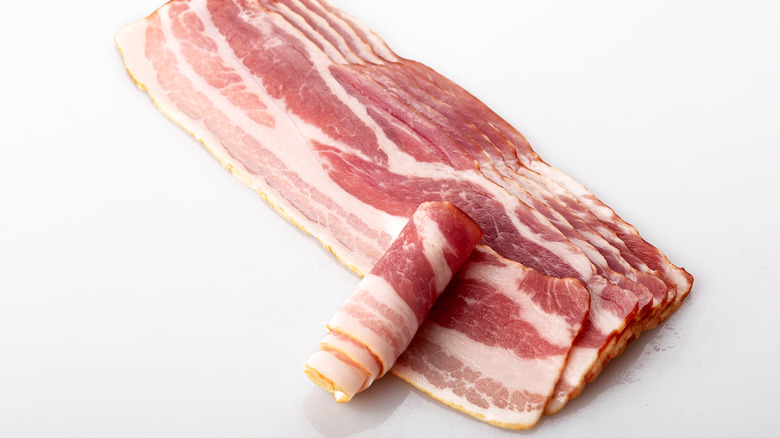The Reason You Should Avoid Thick-Cut Meat When Making Candied Bacon
Sweet, salty, and smoky is what well-made candied bacon should taste like. As for texture, it should be crisp and perfectly caramelized, crackling just slightly between your teeth as you take a bite. However, the reality is that achieving these attributes can be difficult without the proper know-how. Despite the fact that technique is the driving force behind success, starting with the right ingredients is just as essential. For this very reason, you should think twice before working with thick-cut bacon.
Making lacquered bacon is as simple as coating slices of meat with a sweet ingredient like brown sugar and then baking until caramelized. While sugar is capable of imparting richly toasted and nutty nuances, it can blacken and become bitter in an instant as sugar begins to melt, and its molecules start breaking down. As a result, this sensitivity to heat can pose a problem when sugar is sprinkled over thick-cut bacon. But why?
Since meatier strips of bacon take longer to cook and crisp up, this means that the sugar coating will also be subject to heat for longer, thus increasing the chances of the sugar burning long before bacon has had a chance to fully cook. On the other hand, if lacquered bacon is removed at the first signs of the sugar's caramelization, the meat will be left chewy and undercooked. Either way you look at it, using thick-cut bacon is a risky move when making candied bacon.
The best bacon to candy (and how to prevent it from burning)
When it comes to candying, we recommend using standard slices of bacon, as these thin strips will cook up quickly without burning the sugar coating. Both streaky bacon and lean, center-cut bacon will do the trick, but we recommend streaky bacon for the best results. And, using uncured bacon is Alton Brown's tip for truly great candied bacon. As previously mentioned, technique is important. In fact, it's so important that you might be able to get away with using thicker slices of bacon if you know the right tricks to cook bacon without burning the sugar. Yet, since it can still be challenging to execute, opting for thinner bacon acts as a sort of insurance policy against limp and undercooked meat, just as much as bitter and burnt bacon.
Regardless of the thickness you decide on, there are some things you should keep in mind when cooking. For example, to prevent grease splatters and sugar burns, cook bacon in the oven. Place it on a middle rack and start with the oven cold for more optimal and even heating. Additionally, laying sugar-sprinkled strips on a wire rack will produce the crispiest bacon; just remember to place that wire rack directly on top of a sheet pan to catch the grease. Lastly, always pay attention to bacon as it cooks instead of setting and forgetting a timer. With these tips, you'll master the art of making candied bacon in no time!

